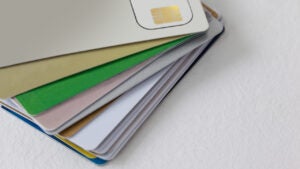8 tips for using gas credit cards wisely

Key takeaways
- Using a gas credit card can help you earn rewards and cash back on gasoline purchases.
- Stacking rewards from both your gas card and a gas station loyalty program can help you build even more savings.
- Though gas cards are useful, their savings are relatively modest, which makes it important that you use them properly.
Although gas prices have dropped from their all-time highs, the current national average of over $3 per gallon, according to AAA, still has consumers feeling the pinch at the pump. One way to save money on gas is with gas rewards credit cards, which can help you earn rewards on your gas purchases.
Gas credit cards are available as private label cards for specific gas brands or as co-branded cards issued by banks. There are also gas charge cards that aren’t part of a larger payment network like Visa or Mastercard and can only be used for purchases from the gasoline retailer. Rounding out these options are credit cards that offer bonus rewards for gasoline purchases, regardless of where you refill at the pump.
But just having a gasoline card doesn’t mean that you’re saving as much money as possible on gas. Here are some tips for using gas credit cards wisely:
1. Don’t carry a balance
Paying interest can offset any benefits you receive from using a gas card. A typical gas credit card can have interest rates between 20 percent and 30 percent APR. When you carry a balance, the interest charges that you pay can easily exceed the value of the cash back or other rewards that you earn. Therefore, you should only use a gas card when you can avoid interest by paying your statement balance in full every month.
“As long as you’re paying off your balance in full every month, a good rewards gas card is found money.”
— Joe Ridout Spokesman for consumer advocacy group, Consumer Action
Gas rewards cards are not appropriate for consumers who carry a balance because these cards tend to have higher annual percentage rates than regular credit cards,” cautions Joe Ridout, spokesman for Consumer Action.
Here are Bankrate’s picks for best credit cards for gas rewards. Before you choose one, be sure to compare the APRs, especially if you plan to carry a balance.
2. Combine your card savings with gas station rewards programs
One of the best ways to save at the pump is to stack your gas card rewards with points you earn through a gas station rewards program. Many gas stations offer loyalty programs that allow you to earn points on fuel and in-store purchases. You can redeem these points for discounts when you fill up your gas tank. Some programs even allow you to connect a credit card to your loyalty account (like a great cash back card), helping you earn loyalty points for qualified spending at restaurants, online shopping and more.
To take advantage of these savings, simply scan your loyalty card whenever you make a purchase. You can earn points for your purchase or use the points you already have to get a discount. Then, pay for your purchase with your preferred gas card to earn additional rewards or cash back with your card on top of the loyalty points you’ve earned for your purchase.
3. Don’t pass up cheap gas to use your gas card
Before signing up for a gas rewards card, look at your gas-buying habits. Where and how often do you fill up your gas tank? Do you burn gas on road trips when you travel? Do you need a gas rewards card or could you simply switch to a gas station with lower prices?
Unfortunately, too many drivers pass by the lowest price gas and visit the stations where they have a gas card — and often end up with minimal savings or even paying more.
In addition, consider the differences between private label cards — also called retail cards — and co-branded cards. When you have a card that gives you additional points, miles or cash back for gas purchases, then you can shop around for the best gas price and still earn rewards. Just keep in mind that gas bought at warehouse fuel centers like Costco and Sam’s Club won’t be eligible for most cards’gas category bonus rates.
4. Don’t drive out of your way to earn rewards
The savings offered by gas credit cards are small but significant. However, even if you have to drive a few extra miles to fill up, the gas you waste can largely offset your savings. You also have to consider the value of your time as well as other costs associated with maintaining your car. To best use a gas card associated with a specific retailer, make sure that you aren’t driving to stations that are out of your way.
Let’s assume you get 20 miles per gallon while driving in town, and you drive 1.5 miles out of the way (3 miles round trip) to purchase gas at a specific station. With gas at $3.25 per gallon, you’ve spent about $0.49 in gas to make the trip. If your card earns 1 percent cash back on $50 of gas, you only earn $0.50 — which is essentially what you’ve paid to make the trip. Even at 2% cash back, you’ve spent about half of your earnings just getting to the gas station.
5. Consider how and when you’ll collect rewards
Some rewards programs cap your rebate amount or set a minimum threshold for cashing out. Other gas cards or gas rewards programs may offer rewards in the form of a discount on a single fill-up. This can deliver much more value to a car with a large gas tank than a smaller one.
Other cards offer reward points without a clearly specified value. Be sure to understand how valuable the points are before committing to a specific card.
6. Check the rewards cards you already have
If you’re not a heavy gas user, then you might be better off with a general rewards credit card that allows you to earn points for purchases in other categories as well. In fact, some of these rewards programs are pumping up incentives by offering accelerated rewards in rotating quarterly categories — which often include gas. Here are some of our picks for the best cards with rotating bonus categories.
7. Understand the card’s terms
Private-label gas cards can have less competitive rates and terms, on par with subprime cards offered to those with credit problems. That means you should watch out for high APRs, late payment fees, over-limit fees and enticing welcome offers on these cards, as they’re often designed to lure in the desperate.
You’d wipe out the rebate savings from a gas rewards card by paying a high APR or fees. If you think you might carry a balance or incur late fees, you should be looking for a general-purpose card that offers the best possible terms.
8. Don’t overestimate gas savings
It can be easy to get excited about earning cash back on gas, especially if you’re earning 3 percent or more. However, it pays to do the math ahead of time to understand just how much savings you’ll earn.
Although newer cars are more fuel efficient, according to the U.S. Department of Energy, the average fuel economy for a passenger car is about 24 miles per gallon. Additionally, the U.S. Department of Transportation Federal Highway Administration’s most recent numbers report that the average driver travels about 13,476 miles per year.
Someone driving 13,000 miles in a car that gets 24 miles to the gallon will consume about 542 gallons per year. Based on the current average price of a gallon of gasoline, which is $3.04, this will cost about $1,648 per year. Even if you are using a card that offers 3 percent cash back on gas, this will only result in about $49 in annual savings. That might not be enough to cause you to switch credit cards.
The bottom line: Are gas credit cards worth it?
Credit cards can be a great way to save money on gas, but only when used wisely. By choosing the right gas card and being realistic about your potential savings, you can minimize the cost of fueling your car.
And if you’re trying to minimize the costs of fueling your business fleet instead of a personal car? Business gas cards, also called fleet fuel cards, can help you track and save on business-wide fueling expenses for both you and your employees. Just keep some of these tips in mind when deciding on and using your new fleet fuel card.
Why we ask for feedback Your feedback helps us improve our content and services. It takes less than a minute to complete.
Your responses are anonymous and will only be used for improving our website.






